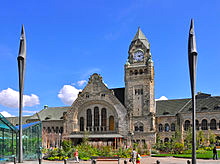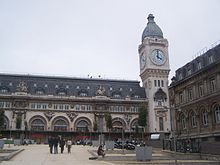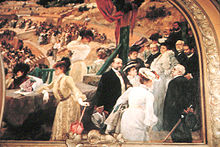Franch Railroad Stations

French Railways. Paris Gare du Nord-Station
The Imperial Station Palace of Metz, France, featuring the apartments of the former Emperor of Germany.
In addition to the basic configuration of a station, various features set certain types of station apart. The first is the level of the tracks. Stations are often sited where a road crosses the railway: unless the crossing is a level crossing, the road and railway will be at different levels. The platforms will often be raised or lowered relative to the station entrance: the station buildings may be on either level, or both. The other arrangement, where the station entrance and platforms are on the same level, is also common, but is perhaps rarer in urban areas, except when the station is a terminus. Elevated stations are more common, not including metro stations. Stations located at level crossings can be problematic if the train blocks the roadway while it stops, causing road traffic to wait for an extended period of time.
Occasionally a station serves two or more railway lines at differing levels. This may be due to the station’s position at a point where two lines cross (example: Berlin Hauptbahnhof), or may be to provide separate station capacity for two types of service, e.g. intercity and suburban (examples: Paris-Gare de Lyon and Philadelphia’s 30th Street Station), or for two different destinations.
Stations may also be classified according to the layout of the platforms. Apart from single-track lines, the most basic arrangement is a pair of tracks for the two directions; there is then a basic choice of an island platform between, or two separate platforms outside, the tracks. With more tracks, the possibilities expand.
Some stations have unusual platform layouts due to space constraints of the station location, or the alignment of the tracks. Examples include staggered platforms, such as at Tutbury and Hatton railway station on the Derby – Crewe line, and curved platforms, such as Cheadle Hulme railway station on the Macclesfield to Manchester Line. Triangular stations also exist where two lines form a three-way junction and platforms are built on all three sides.
Paris-Gare de Lyon
Outside the station, with its large clock tower.
Paris Lyon (or Gare de Lyon) is one of the six large mainline railway station termini in Paris, France. It handles about 90,000,000 passengers every year, making it the third busiest station of France and one of the busiest of Europe. It is the northern terminus of the Paris–Marseille railway. It is named after the city of Lyon, a stop for many long-distance trains departing here, most en route to the south of France. In general the station’s SNCF services run to the south and east of France. The station also hosts regional trains and the RER. It is served by the Gare de Lyon metro station. The station is located in the XIIe arrondissement, on the north bank of the river Seine, in the east of Paris.
Inside the station.
The station was built for the World Exposition of 1900. On multiple levels, it is considered a classic example of the architecture of its time. Most notable is the large clock tower atop one corner of the station, similar in style to the clock tower of the United Kingdom Houses of Parliament, home to Big Ben.
The station houses the Le Train Bleu restaurant, which has served drinks and meals to travellers and other guests since 1901 in an ornately-decorated setting.
19th Century wall painting by Albert Maignan inside the “Le Train Bleu” restaurant, in the hall of the Paris-Lyon Railway Station.
On 27 June 1988, a runaway train crashed into a stationary rush-hour train, killing 56 people and injuring a further 55.
The station was featured in the comic film Mr. Bean’s Holiday, starring Rowan Atkinson.





